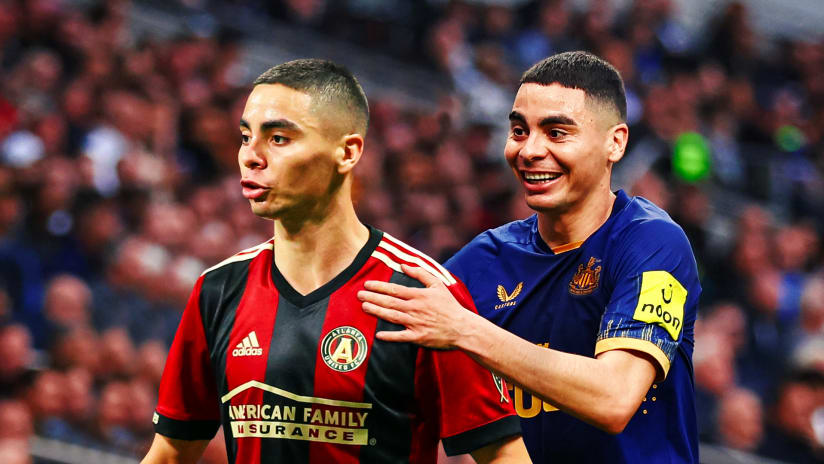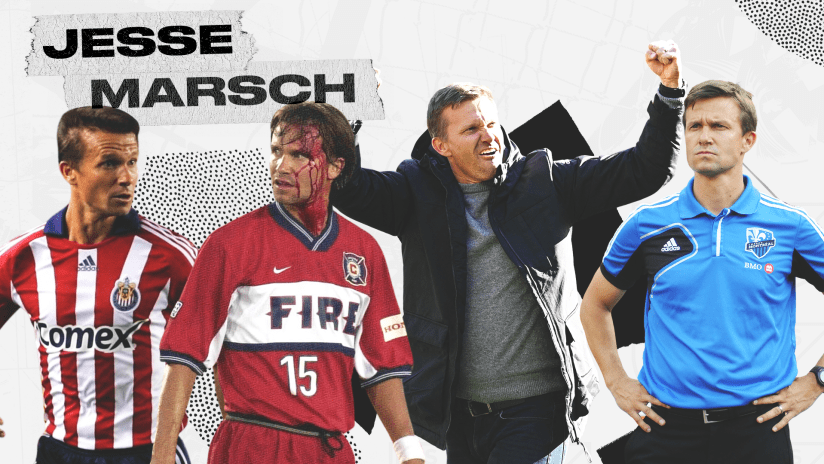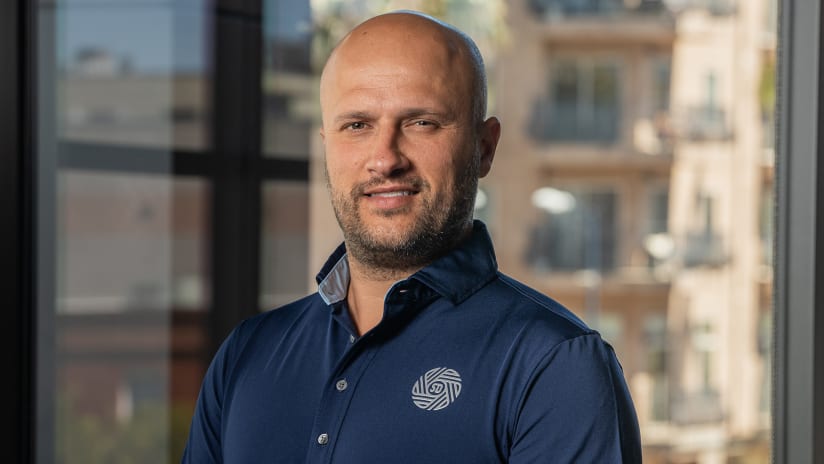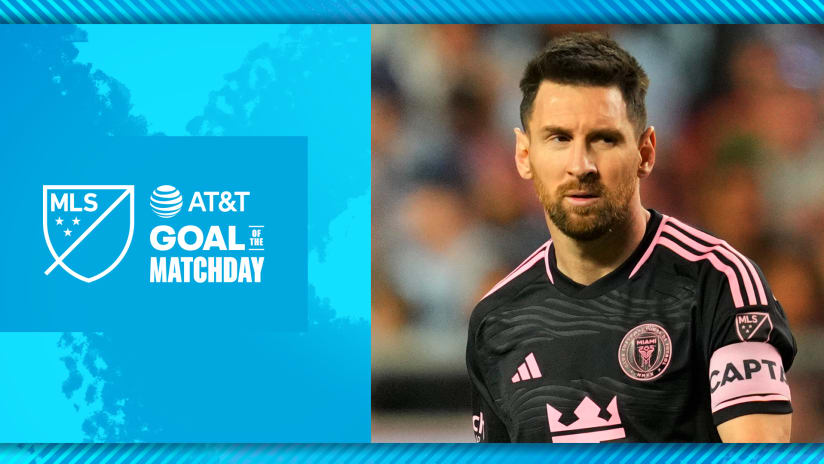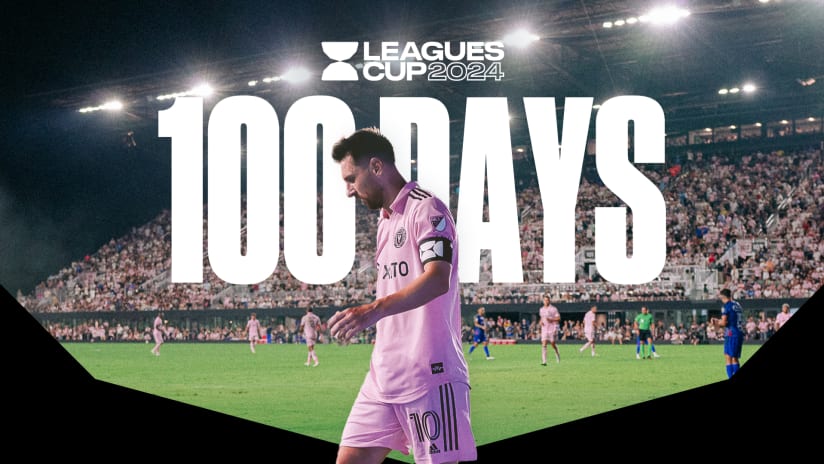“You go a game or two without a goal, and you start to think you’ll never score again.”
Taylor Twellman, who scored 101 goals during his eight-year career with the New England Revolution, pauses for a second before continuing, as if he needs a moment to himself.
“I think all guys who are paid to score know the feeling,” he says. “Lying awake at night, agonizing about it all day, your food tasting like cardboard. It’s awful.”
To overcome the anxiety, Twellman would stay after practice to do extra work. Not extra sprints or heading drills. This was the mental work every goalscorer seems to put in. For Twellman, this meant standing in front of an empty goal, and from a range where he could not possibly miss, firing the ball in. Over and over.
“No matter what kind of practice I'd just had, I wanted it to end with me seeing the ball hit the net,” Twellman says. “I always wanted a mental picture of what it looked like.”
Ante Razov, Major League Soccer’s fourth all-time scorer, had a similar ritual.
“I was like a jump shooter in basketball with his two or three favorite spots on the floor,” Razov says. “I’d go to those spots, in and around the box, and try to put shots into places where I knew they could not be saved. Upper corners, lower corners, spin it both ways. In a game, I wanted to feel like I could hit those spots with my eyes closed.”
And Chris Wondolowski, whose 27 goals in 2012 famously tied the MLS single-season goalscoring record, sometimes actually does away with the ball.
“It’s very personal,” the San Jose Earthquakes forward says of his routine. “It’s visualization. Sometimes, I just walk around the box and try to see myself scoring a goal.”
And though none of them mention any kind of religious act, all talk about a prayer of sorts, said to no one in particular.
Please, let me score again.
Nature vs. Nurture
It’s an interesting life the goalscorers lead. They are, at one and the same time, the most praised and most criticized players on the field. They can be heroes and goats, often within the same 90 minutes. They grace the billboards and get the biggest contracts. And the best of them have their names remembered forever, their names spoken in reverent tones down through the years.
We talk about goalscorers in almost mystical terms. They “thrive on instincts.” They “do things you can’t teach.” They “show up in the right place at the right time.”
But what does all of that really mean? What makes a goalscorer? Can you even make one, construct one, design and manufacture one? Or are the mystics right when they say that the best goalscorers are simply conjured from thin air?
First, the idea of instincts.
Razov (left) scored 114 goals in his MLS career, the majority of them during a torrid stretch with the Chicago Fire from 1998-2004. He finished with double-digit goal totals in seven different seasons, including back-to-back campaigns with Chivas USA in 2006-07. (Note: For clarification purposes, this article only includes regular-season goals unless otherwise noted.)
“I know I can’t speak for everyone, but I think you’re born with something,” says Razov, who boasted one of the best left-footed shots in league history. “I don’t know what to call it. Instinct, knack, desire. It’s just knowing in a rough way how to go about scoring goals. That’s where you start. If you have that, then it can be polished off with coaching and practice.”
Wondolowski concurs, to a degree. He won the league’s scoring crown in 2010 and 2012 and a share of it in 2011, racking up 61 goals over 90 regular-season games heading into this season. He inked a new contract earlier this year that makes him one of the highest paid players in the league, because the Earthquakes believe that his instincts around the goal are the best in MLS today.
“If anticipation is an instinct, then I think there’s an instinctive part to being a goalscorer,” he says. “I think anticipation is the most important thing for a goalscorer. But I also think you can improve your anticipation by studying the game, by learning the tendencies of the defenders and your teammates.”
So it starts with instinct, something innate that tells a young boy to run in one direction rather than another because he senses, somehow, that the ball will arrive there and he will score. But once that instinct is recognized by someone, the “polishing,” as Razov describes it, takes the goalscorer to the next level.
Twellman, who is now an on-air analyst for ESPN, didn’t start polishing his talents until he got to college. A three-sport star athlete in high school, he attended the University of Maryland on a baseball scholarship. But he was also a budding soccer star, and in 1999 he left Maryland to play for the US Under-20 national team at the World Cup in Nigeria. The team was coached by current Seattle Sounders manager Sigi Schmid and an assistant named Wolfgang Sunholz, who is today in charge of the Austin Aztex U-23 team.
“After four times watching me in training, Wolfgang says, ‘You have no idea how to make a run, do you?’” recalls Twellman, who scored four goals at the 1999 U-20 World Cup, tied for the third most at the tournament. “He started to talk to me about timing and persistence. Then I started watching guys like (former England striker) Alan Shearer on video, and it started to make sense. I was 18 years old before I learned how to make a run.”
That’s the often-overlooked aspect of the goalscorer’s talent: the run. Match highlights ignore that part of the action. They focus on the finish: the rise to head home a cross, the slide at the far post to sweep the ball in, the dribble move before the rocket into the lower corner. But rarely does any of that happen with the run — to the far post, to the near post, check-back, delayed, diagonal, circling back, all manner of runs to find the space and get into a position to put a chance away.
“I learned that 30 yards from the goal is where I’d have to make my money,” Twellman says. “Because 30 yards from goal is where I have to take the defender off his game by half a yard. If I’ve got him on his heels for half a yard during my run, I’ve got the game won if my teammate sees me.”
A forward may have to make these runs 100 times to get that half yard just one or two times during a game. And even then, you might not get the chance you need to break through.
As Wondolowski puts it, “Make the run 100 times. And if that doesn’t work, make it 101.”
When opportunity knocks
Like most things in sports, perception and reality are often at odds when it comes to assessing goalscorers. A guy who gets hot for a month, putting away a high percentage of his chances, gets labeled a great finisher, while a guy who gets a lot of chances but no goals gets called other things, by fans, coaches, teammates, most not suitable for print.
“I think it’s more disconcerting when you’re not getting chances than when you’re not getting goals,” says Kreis, who scored 108 goals in 305 MLS games. “When you’re not getting chances, it’s probably a team thing, but you start to question yourself a lot.”
Says Twellman: “There were times where I’d walk off the field asking myself, ‘What the hell are you doing, Taylor?’ We’d have just tied 0-0 or 1-1 and I’d have only gotten two chances to score and missed them both. I couldn’t eat or sleep after those games. It’s like a disease, scoring goals. I mean, it’s a disease I liked having. But it’s a disease.”
Sometimes the only cure for the disease is banishment. No one wants a goalscorer around who isn’t scoring, especially one who hasn’t proven himself capable of pulling out of the slump.
In 1996, for example, New York signed a Colombian striker named Rubén Darío Hernández, who came to MLS as the leading scorer in the Colombian first division. Immediately, “Rubencho” got chances to score. Plenty of chances. But in 10 games, he scored not a single MLS goal. And in due course, he was sent packing by then-coach Carlos Queiroz. His replacement, another Colombian, named Antony de Ávila, was a pesky 5-foot-3 striker who had played in a World Cup but was on the downside of his career. But he proceeded to score eight goals in 11 games in the regular season and playoffs in 1996.
What was the difference? Did de Ávila just get more chances than Hernandez? Not statistically. His 10 goals came on 26 shots, 17 of which were on goal; Hernández had 34 shots, 16 on target. Did some new playmaker show up in New York after Hernández was jettisoned? No, it was roughly the same squad. But one of them put his chances away; the other didn’t.
“My whole point of every game I ever played was to get four to five chances,” says Twellman (right). “If I got four to five chances, I felt good that I’d get one goal, if not two.”
Of course the more chances you get, the better odds for the goalscorer. It helps to have a steady playmaker who understands your movements, and vice versa.
“I got grief in Chicago for missing a lot of chances during what were some of my best seasons in terms of goal scoring numbers,” Razov says. “But, with the team we had, I was getting a lot of chances. The way I looked at it was, if I’m getting chances, the goals were going to come at some point. And they did.”
Look around at the best scorers in league history, and there’s usually a significant set-up man nearby. Twellman had MLS all-time assist leader Steve Ralston, Razov had Peter Nowak in Chicago, Jaime Moreno had Marco Etcheverry at D.C. United, and Edson Buddle, who is currently the next closest to the century mark with 93 career regular-season goals, had Landon Donovan during his best days in Los Angeles.
The rule of the assist man is not universally true, though. All-time leader Jeff Cunningham bounced around with five different teams and never connected with any individual player more than nine times. But he was a different breed of goalscorer, one who created his own chances with his speed. And like all his counterparts, he was only as good as the chances he got.
The will and the way
How do goalscorers get their chances? There are too many ways to count.
There are the guys who can create on their own, with the aforementioned Cunningham being among the most famous to ever play in MLS. Cunningham’s speed scared defenders. That was his blessing. But it may also have been his curse.
Cunningham, who scored 134 goals in 365 games with five different clubs, was a 1-v-1 artist not known for combining well with teammates on the field (or off, for that matter). So, when he was not scoring goals, he could be a frustrating presence in a team’s lineup.
He is not the only goalscorer in MLS history who’s been tagged as selfish. Mamadou Diallo, who scored 47 goals in 74 games for the Tampa Bay Mutiny, New England Revolution and MetroStars, never saw even a fractional opportunity to shoot that he passed up. He took 327 shots in in career, including one, Twellman recalls, from the center circle after the receiving the ball on opening kick off in a game with the Revolution in 2002.
As effective as those type of players can be, they can frustrate their teammates. Razov recalls struggling alongside former Fire teammate Damani Ralph, who scored 11 goals in 2003.
“He was impossible to combine with,” Razov recalls. “Everything Damani did was on his own. It kind of drove me up the wall. Damani was the greatest guy ever. I loved Damani. But it was very frustrating to me because combining was not in his game at all. The ball went in to him and it wasn’t coming out. It worked for a time, but that was a painful one for me.”
Painful, Razov says, because he thrived on having teammates who understood his movements with and without the ball. (Sidenote: Razov didn’t struggle too much alongside Ralph: He notched 14 goals himself in 2003.) Unlike Cunningham, Diallo, and Ralph (left), Razov was a player who looked to combine with his midfielders to manipulate the defense and orchestrate an opening and a chance.
“Ante was at his best playing with the guys on the early Fire teams,” says C.J. Brown, one of Razov’s former Fire teammates and currently an assistant coach with Real Salt Lake. “Guys like Roman Kosecki and Peter Nowak would play balls into Ante, he’d find someone else with a little pass, and then Ante would be in on goal for a chance.”
Twellman got his chances in an altogether different way. He rarely took players on 1-v-1, and he didn’t necessarily want to combine in tight spaces with teammates. For him, it was about making a run, creating that aforementioned half-yard on the defender, and getting into the box to connect with crosses.
“I knew if Brian Kamler or Steve Ralston got the ball on the left or right, I just had to get open,” Twellman says, recalling his Golden Boot-winning season in 2002. “I knew they were going to deliver balls, and I needed to be ready. It wasn’t by chance. Steve and I were roommates, and we’d sit in the room and talk. Some nights I’d say, ‘Tomorrow I’m going back post all day because the defender bites on the near-post run.’”
When the Revolution’s personnel changed in the mid 2000s, and players like Clint Dempsey, Pat Noonan, Andy Dorman and Shalrie Joseph were brought in, Twellman had to adjust.
“[They] wanted to combine,” Twellman says. “We became more of a 3-5-2 team, with Dempsey playing underneath the strikers. So I had to learn his tendencies. He was a tough one to figure out. He was very tricky and not as simple as our team was. It was up to me to learn new ways to make runs and get myself chances.”
Twellman succeeded. He won the Golden Boot again in 2005.
Different players, common currency
In sports, there is a phenomenon known as the myth of the predetermined outcome. In soccer it usually goes like this: “If he scored there, we would have won that game.”
It’s understandable in a sport as low-scoring as soccer. We go to games hoping to see multiple balls hit the net, but we know that we could get only one. So when a goal is scored, for or against, it is often feels monumental.
Again, it’s a myth. Each goal you witness does not determine the outcome of a game. It only feels that way. But while a goal doesn’t always decide a game, it almost always changes it. What’s the most important goal in a game? Easy answer: The next one.
“In my job now, watching, analyzing and commenting on games, I find myself focusing a lot on reactions,” Twellman says. “And I think you can tell a guy is born to score goals when he misses a chance and it doesn’t bother him. There’s no real conscience.”
The irony is not lost on Twellman. All he believes he was doing was giving every ounce of effort, maybe even as a way of running off the anxiety he was feeling in his gut. Turns out he was a human contradiction. Full of doubt, but exuding extreme confidence.
“I never realized it when I was playing,” he says, “but I see it now. Defenders hate forwards who are a nuisance, and I guess that was me. [Red Bulls head coach and former MLS player] Mike Petke said to me, ‘I hated playing against you.’ And I said to him, ‘That’s actually the best compliment I’ve ever gotten.’”
It’s probably the only trait all great goalscorers have in common.
Scan the list of players who have tallied 100 or more goals in MLS and you’ll come to the conclusion that there is no such thing as a prototypical goalscorer. As former MLS Defender of the Year and current Red Bulls assistant coach Robin Fraser observes, “You see seven players who were distinctly different in the way they played and scored.”
On Cunningham: “He had you most worried when he had the ball 30 yards away from the goal and you knew no one was around to help you. That made for a very scary couple of seconds. If he got by you, it was all over.”
On Moreno, who in his best days could tilt a defender at light-speed, change direction and finish with either foot: “He scored goals that were unimaginable. By that I mean, he finished in ways that no one else would have even tried.”
On Donovan: “From the time he was 18 he had movements so unbelievably sharp and precise that he created constant problems for a defender. When you think of most of Landon’s goals, it’s one perfect touch to set up his finish.”
On Razov: “Pulling him offside nine times out of 10 wasn’t good enough. He was always challenging the line and if he stayed onside once it was trouble.”
On Kreis, who had as powerful a right foot as anyone who’s ever played in MLS: “I’d love to see how many times he scored with his head. More than people realize. He was mostly known for his powerful shots and free kicks, so people may not remember him as a guy who was always in the right place at the right time. As a defender, I do.”
On Twellman: “Made tremendous use of service in the box. He could score with either foot, with his head, just as long as his teammates were putting balls in the box.”
On Dwayne De Rosario, who last year reached the 100-goal mark: “Only seems to score highlight goals.”
No two exactly alike in terms of the way they typically scored, but very much alike in the fulfillment of their mission. What connects them? Is there a thread between them and the league’s best scorers today, like Wondolowski and Real Salt Lake’s Alvaro Saborio, the Houston Dynamo’s Will Bruin, and the Philadelphia Union’s Jack McInerney?
You bet there is. It goes back to the prayer. You are only as good as your next goal.
“I think most of us who make our living scoring goals,” says Razov. “We play like the world is tilted maybe a little uphill. We tend to press. We tend to be very hard on ourselves. But at the same time, yeah, in every game I played, I expected to score.”
Just one more. Again and again.




